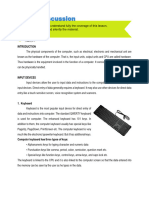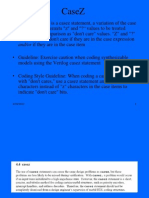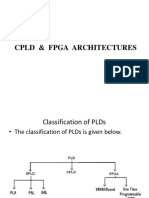Third Quarter Examination in Contemporary Arts
Third Quarter Examination in Contemporary Arts
Uploaded by
Martinelli Ladores CabullosCopyright:
Available Formats
Third Quarter Examination in Contemporary Arts
Third Quarter Examination in Contemporary Arts
Uploaded by
Martinelli Ladores CabullosOriginal Description:
Copyright
Available Formats
Share this document
Did you find this document useful?
Is this content inappropriate?
Copyright:
Available Formats
Third Quarter Examination in Contemporary Arts
Third Quarter Examination in Contemporary Arts
Uploaded by
Martinelli Ladores CabullosCopyright:
Available Formats
Republic of the Philippines
Department of Education
Region III
School Division of Nueva Ecija
PENARANDA NATIONAL HIGH SCHOOL
SENIOR HIGH SCHOOL
Penaranda, Nueva Ecija
FIRST QUARTER EXAMINATION IN
CONTEMPORARY PHILIPPINE ARTS FROM THE REGION
Name: _________________________________________ Date: ____________________
Year and Strand: ______________________________ Score: ___________________
I. MULTIPLE CHOICES: Encircle the correct answer.
1. Art produced at the present period in time.
a. Contemporary art b. abstract c. paint d. music
2. A Contemporary art include and develops from ________.
a. Painting b. mosaic c. postmodern art d. music
3. Postmodern art which is itself a successor of _______.
a. Abstract art b. sand art c. fine art d. modern art
4. Is a style of expressive dance that combines elements of several dance
genres including modern, jazz, lyrical and classical ballet.
a. Contemporary dance b. visual design c. modern art d. music
5. Contemporary dancers strive to connect the mind and the body through ___.
a. Dance b. movements c. fluid dance movements d. spirit
6. Commonly known as gangsaand played by the groups in the Cordillera
region of the bossed gongs played among the Islam and animist groups in the
Southern Philippines.
a. Flat gong b. kaleleng c. maracas d. tambuli
7. Is long and has a narrow internal diameter, it is possible to play different
harmonics through overblowing—even with the rather weak airflow from one
nostril.
a. Flat gong b. maracas c. kaleleng d. tambuli
8. Refers to any piece of written material.
a. Literature b. arts c. Literary composition d. design
9. Is the use of imagery, color, shapes, typography, and form to enhance usability
and improve the user experience.
a. Literature b. arts c. design d. visual design
10. Refers to art made and produced by artists living today.
a. Contemporary art b. design c. arts d. visual design
11. Is art produced by Filipino artists coming from the different regions in the
Philippines in the 21st century.
a. Art b. design c. contemporary Philippine arts d. literature
12. Foreign influenced, industry-driven, technology assisted, oriented for mass-
consumption.
a. Alternative b. design c. art d. dominant/mainstream
13. Usually social realist and/or advocacy-oriented.
a. Rock b. dominant/mainstream c. alternative d. design
14. Preserves local traditions.
a. Alternative b. design c. art d. traditional/Indigenous
15. Refers to art approaches or techniques that involve the use of combination or
mixed mediums.
a. Alternative b. design c. art d. Integrative art
16. Refers to anything that attracts the five senses and thus its mediums may be
visual, auditory, olfactory, tactile and gustatory.
a. Design b. art c. alternative d. fine arts
17. Emphasizes form achieved through color ― intensity, saturation, brightness,
contrast, and the use of combinations in conveying the subject.
a. Fine arts b. painting c. mosaic d. design
18. Focuses on form achieved through texture and dimension. They are never flat in
dimension and could be smooth, rough, soft, hard, shiny, pointed, etc. depending on
the texture of materials used.
a. Painting b. carving c. sculpting d. taka
19. Gained recognitions and awards from prestigious national or international literary
institutions.
a. Natl. artist in dance b. Phil. Natl. artist in Literature c. Jose Rizal d. Natl. artist in Music
20. In the selection process of National Artist in the Philippines, who is the last
person that will approve the selected artist by the three panels?
a. Phil. President b. Commissioners c. Panels d. CCP Governors
II. Identification: Identify the following National artist. Select your answer in the
box.
Fernando Amorsolo Napoleon Abueva Nick Joaquin Pablo Antonio
Guillermo E. Tolentino Amado V. Hernandez F. Sionil Jose Leandro V. Locsin
Carlos “Botong” Francisco Jose Garcia Villa Juan Nakpil Ildefonso P. Santos
Jose Maria Zaragosa Francisca Aquino Ramon Obusan
III. Enumeration: Enumerate the following: 1-15
What are the different contemporary art forms?
1. _______________________________________________________
2. _______________________________________________________
3. _______________________________________________________
4. _______________________________________________________
5. _______________________________________________________
Give at least 5 significant landmarks that you can found in your hometown.
1. _______________________________________________________
2. _______________________________________________________
3. _______________________________________________________
4. _______________________________________________________
5. _______________________________________________________
Classify various art forms found in the Philippines.
1. _______________________________________________________
2. _______________________________________________________
3. _______________________________________________________
4. _______________________________________________________
5. _______________________________________________________
Prepared by:
MARTINELLI L. CABULLOS
Teacher II
OLGA F. DELA CRUZ
Master Teacher II
SHEILA B. POLICARPIO Checked:
Teacher III
RONEL E. PINEDA ROGELIO C. DRAPIZA, Ph.D.
Teacher II Asst. Principal II
RITCHELL ANN U. SAGAT Noted:
Teacher II
MIRIAM S. MONTEROSO
School Principal IV
1. His masterpieces showcase rural landscapes which applied light techniques
(chiaroscuro) and impressionistic brush strokes.
___________________________________.
2. Known as the father of Philippine classical sculpture, he immortalized in bronze
and stone the country’s greatest symbols and heroes ― the Bonifacio
Monument, UP Diliman’s Oblation, the Quezon Memorial, the bronze medal of
the Ramon Magsaysay award, and the seal of the Republic of the
Philippines.__________________________________.
3. Painter from Angono, Rizal who was known for the vivid and vibrant colors of
his expressionistic murals about the country’s historical events.
_______________________.
4. Known as the father of Philippine modern sculpture, he hails from Bohol and
became famous for his artistic statues Blood Compact, Nine Muses, Kiss of
Judas, and the Transfiguration.________________________________.
5. His poems and novels written purely in the Filipino mother tongue tackle the
issues of the poor and the working class. ___________________________________.
6. The “master of the comma poem”. _______________________________.
7. It was his mystery- and suspense- filled novels that became his trademark style.
______________________.
8. A native of Rosales, Pangasinan, he often gleans local legends and epics from
his hometown as well as from the Ilocos region to include in his short stories
and novels. ______________.
9. A native of Quiapo, He was the first to be made National Artist in 1973, His
famous works in neoclassic style are the Rizal Shrine, Manila Jockey Club, UP
Theater and Carillon Tower, UP Quezon Hall and Library.
_________________________.
10. The 2nd Filipino architect to be declared National Artist in 1976.
__________________.
11. An architect from Silay, Negros Occidental, he was known for the use of
domes, spirals, and concentric spaces. _____________________.
12. This father of Philippine landscape architecture from Malabon took charge of
the landscaping of the following parks. ________________________.
13. Fused old world Spanish colonial style with modern international as seen in his
masterpieces the Santo Domingo Church and the Meralco Building.
14. Is acknowledged as the Folk Dance Pioneer.
15. He promoted the unique and graceful dances of the Philippines via
performances here and around the world.
You might also like
- Philippine Contemporary Art Quiz 1Document1 pagePhilippine Contemporary Art Quiz 1Virgilio Rosario Biagtan81% (21)
- 1st Quarter Examination Contemporary ArtsDocument4 pages1st Quarter Examination Contemporary Artsnicky tampoc92% (13)
- Full-Blown ResearchDocument42 pagesFull-Blown ResearchAnonymous WdTq28euhw93% (15)
- HUMSS - Creative Nonfiction CG PDFDocument7 pagesHUMSS - Creative Nonfiction CG PDFDlanor Bacan-Pacuño Baa100% (1)
- Diagnostic Examination Contemporary Philippine Arts From The RegionsDocument3 pagesDiagnostic Examination Contemporary Philippine Arts From The RegionsRoselyn Astronomo100% (1)
- Contemporary Arts 1st Quarter ExamDocument4 pagesContemporary Arts 1st Quarter Examedward Ayala77% (13)
- Cpar Diagnostic TestDocument3 pagesCpar Diagnostic TestArman Cambe100% (2)
- 1st Periodical Exam in CPAR ANSWER KEYDocument3 pages1st Periodical Exam in CPAR ANSWER KEYRS Dulay75% (8)
- CPAR 12-2ND Quarter Summative Test (2022)Document3 pagesCPAR 12-2ND Quarter Summative Test (2022)Ada Ricana100% (5)
- Contemporary Phil ArtsDocument36 pagesContemporary Phil ArtsGinle SatumcacalNo ratings yet
- Contemporary Arts Exam 3rd QuarterDocument4 pagesContemporary Arts Exam 3rd QuarterJohnsun Galado100% (1)
- CPAR 4th Quarter ExamDocument4 pagesCPAR 4th Quarter ExamVergel Felicia67% (3)
- Final Exam Contemporary ArtsDocument2 pagesFinal Exam Contemporary ArtsGlenda Ortillano Lee90% (10)
- Contemporary Midterm ExamDocument5 pagesContemporary Midterm ExamSheenLibarnesYparraguirre100% (5)
- Pre Test in CPARDocument2 pagesPre Test in CPARJeffReyT.Ausan100% (4)
- First Midterm Exam in Contemporary Philippine Arts in The RegionsDocument3 pagesFirst Midterm Exam in Contemporary Philippine Arts in The RegionsRustomGaton89% (18)
- Cpar Nat'l Artist Summative TestDocument4 pagesCpar Nat'l Artist Summative TestIekzkad Realvilla100% (1)
- Contemporary Arts 12. 1ST Quarter Summative Test - MDMDocument5 pagesContemporary Arts 12. 1ST Quarter Summative Test - MDMmarilyn monfero80% (5)
- 1st Quarter Exam in Contempo..Document2 pages1st Quarter Exam in Contempo..May-Ann S. Cahilig100% (9)
- CPAR Periodical Exam 2nd QuarterDocument2 pagesCPAR Periodical Exam 2nd QuarterJoseph Gacosta100% (4)
- Perdev Answer KeyDocument5 pagesPerdev Answer KeyMartinelli Ladores Cabullos96% (46)
- T HR Ci 12040 ST PDFDocument33 pagesT HR Ci 12040 ST PDFtaarak143No ratings yet
- Embedded Design PGADocument2 pagesEmbedded Design PGAsreenathgopalNo ratings yet
- Cpar Summative Assessment G12 Quarter 1 Week 1 and 2Document3 pagesCpar Summative Assessment G12 Quarter 1 Week 1 and 2alyana angeles33% (3)
- Cpar Third Quarter ExamDocument4 pagesCpar Third Quarter ExamGEMMA HIDALGO100% (1)
- S.K. Pendatun Ave., Mo. Poblacion, Cotabato CityDocument3 pagesS.K. Pendatun Ave., Mo. Poblacion, Cotabato CitySarah Abas LptNo ratings yet
- Third Quarter Examination in Contemporary ArtsDocument5 pagesThird Quarter Examination in Contemporary ArtsCristina Divinia Cuevas ManuelNo ratings yet
- Contemporary Art - 1ST Quarterly ExamDocument2 pagesContemporary Art - 1ST Quarterly ExamChia Tan33% (3)
- First Quarter Examination Core 12 - Cpar Contemporary Philippine Arts From The Region S.Y. 2020 - 2021Document5 pagesFirst Quarter Examination Core 12 - Cpar Contemporary Philippine Arts From The Region S.Y. 2020 - 2021Nik BiadoNo ratings yet
- Summative Exam in ContemporaryDocument3 pagesSummative Exam in ContemporaryJerema Joy Reyes MalayoNo ratings yet
- Division of Calamba City Makiling Integrated SchoolDocument5 pagesDivision of Calamba City Makiling Integrated SchoolEditha Balolong100% (2)
- Summative Test Contemporary Philippine Art For The Regions I-Multiple Choice. Write Your Answer in The Space ProvidedDocument2 pagesSummative Test Contemporary Philippine Art For The Regions I-Multiple Choice. Write Your Answer in The Space ProvidedMaria Macel90% (10)
- CPAR Long TestDocument2 pagesCPAR Long TestIekzkad Realvilla100% (5)
- Second Quarter Examination in CPARDocument3 pagesSecond Quarter Examination in CPARZenaida Hipolito100% (5)
- 1st Quarter Test in CPAR 11.docx2 - To Be CheckedDocument10 pages1st Quarter Test in CPAR 11.docx2 - To Be CheckedAureanice Z. Bitas0% (1)
- Exam in Contemporary Arts 1st MidtermDocument2 pagesExam in Contemporary Arts 1st Midtermcherrie r. de guzman100% (2)
- Midterm CPARDocument4 pagesMidterm CPARRubs AD92% (12)
- Q1 Exam Contemporary Philippine Arts From The Regions CDocument2 pagesQ1 Exam Contemporary Philippine Arts From The Regions CPryamn JoefNo ratings yet
- Sultan Naga Dimaporo Memorial Integrated SchoolDocument3 pagesSultan Naga Dimaporo Memorial Integrated SchoolEmee Marieson BelvisNo ratings yet
- CPAR Grade 12 2nd Quarter Final ExamDocument3 pagesCPAR Grade 12 2nd Quarter Final ExamIekzkad Realvilla90% (10)
- First Quarter Examination in CparDocument3 pagesFirst Quarter Examination in CparZenaida Hipolito100% (2)
- Department of Education: Malixi Integrated SchoolDocument3 pagesDepartment of Education: Malixi Integrated SchoolFlomarie Alferez100% (3)
- Final Exam in Cpar 2018-2019Document3 pagesFinal Exam in Cpar 2018-2019Lhen Unico Tercero - Borja100% (4)
- Contemporary Philippine Arts From The Region Summative Test IiDocument2 pagesContemporary Philippine Arts From The Region Summative Test IiChar Layi100% (2)
- Contemporary Arts Gr12 2nd Quarter ExamDocument2 pagesContemporary Arts Gr12 2nd Quarter ExamZerisse Jill Quemada Imasa100% (3)
- First Quarter Exam in CparDocument4 pagesFirst Quarter Exam in CparZENAIDA HIPOLITO100% (3)
- Cpar 1ST QTRDocument4 pagesCpar 1ST QTRJohnArgielLaurenteVictor100% (1)
- 4thquarter Summative Test CparDocument4 pages4thquarter Summative Test CparGuro Biritero Nestor SinlaoNo ratings yet
- THIRD QUARTER Contemporary ArtsDocument4 pagesTHIRD QUARTER Contemporary Artsrod100% (1)
- CAR Final ExamDocument3 pagesCAR Final Examfloramee.resulgaNo ratings yet
- ContemporaryDocument2 pagesContemporaryWALO100% (1)
- Answer-Key-Prelim-CparDocument2 pagesAnswer-Key-Prelim-CparHeicy LabuguenNo ratings yet
- 2nd Periodical ExamDocument3 pages2nd Periodical ExamKrizna Dingding Dotillos100% (3)
- Quarter 1 Exam - Set A - CparDocument3 pagesQuarter 1 Exam - Set A - CparKarla Jenica Patlunag100% (4)
- Cpar Summative Test I Q3Document1 pageCpar Summative Test I Q3Char Layi100% (4)
- FINAL EXAM - Contemporary ArtsDocument8 pagesFINAL EXAM - Contemporary ArtsMaricel Diapana80% (5)
- 2nd Exam Cpar KeyDocument3 pages2nd Exam Cpar Keyedward Ayala0% (1)
- Contemporary Philippine Arts From The Regions ScoreDocument4 pagesContemporary Philippine Arts From The Regions ScoreConje JessaNo ratings yet
- Unit Test in Contemporary ArtsDocument2 pagesUnit Test in Contemporary ArtsKristel Gail Santiago Basilio100% (2)
- I Am Sharing 'Lesson - Plan - in - Contemporary - Philippine - A' With YouDocument73 pagesI Am Sharing 'Lesson - Plan - in - Contemporary - Philippine - A' With YouArkiearkie PaglumotanNo ratings yet
- Contemporary Philippine Arts From The Regions: Table of SpecificationDocument2 pagesContemporary Philippine Arts From The Regions: Table of SpecificationWilma Oriel Nacional86% (7)
- Contemporary Arts of The Region ExamDocument2 pagesContemporary Arts of The Region ExamArnel Boholst100% (1)
- Name: - Track: - ScoreDocument3 pagesName: - Track: - ScoreDA FTNo ratings yet
- CPAR - QUIZ No. 1 - VARIOUS ARTSDocument2 pagesCPAR - QUIZ No. 1 - VARIOUS ARTSEdward B. AcabalNo ratings yet
- Answer Sheet Con Arts Q1 Week 2Document4 pagesAnswer Sheet Con Arts Q1 Week 2Karla Joy Corpuz Marciano100% (2)
- Peñaranda National High School Senior High School Poblacion 1, Peñaranda, Nueva EcijaDocument3 pagesPeñaranda National High School Senior High School Poblacion 1, Peñaranda, Nueva EcijaMartinelli Ladores CabullosNo ratings yet
- TAOISMDocument22 pagesTAOISMMartinelli Ladores CabullosNo ratings yet
- Media and Information Literacy: June 10, 2019Document8 pagesMedia and Information Literacy: June 10, 2019Martinelli Ladores CabullosNo ratings yet
- Guidelines For Fair UseDocument2 pagesGuidelines For Fair UseMartinelli Ladores CabullosNo ratings yet
- Report in Urban SocioDocument17 pagesReport in Urban SocioMartinelli Ladores CabullosNo ratings yet
- Media and Information LanguagesDocument14 pagesMedia and Information LanguagesMartinelli Ladores CabullosNo ratings yet
- AttendanceDocument1 pageAttendanceMartinelli Ladores CabullosNo ratings yet
- Answer Key PerdevDocument5 pagesAnswer Key PerdevMartinelli Ladores Cabullos100% (5)
- The Ethics of Information Use A Teachers Guide: Index To AdvertisersDocument37 pagesThe Ethics of Information Use A Teachers Guide: Index To AdvertisersMartinelli Ladores CabullosNo ratings yet
- School Campaign: For Esc Grantee and Pre-Elementary LearnersDocument10 pagesSchool Campaign: For Esc Grantee and Pre-Elementary LearnersMartinelli Ladores CabullosNo ratings yet
- Bim and Modular Mep Systems For Super-Tall and Mega-Tall BuildingsDocument10 pagesBim and Modular Mep Systems For Super-Tall and Mega-Tall Buildingsel wahabi omarNo ratings yet
- TR - PV System Design NC IIIDocument63 pagesTR - PV System Design NC IIIAljon BalanagNo ratings yet
- Construction MangementDocument14 pagesConstruction Mangementronak100% (1)
- GREEK Column Use ColumnsDocument11 pagesGREEK Column Use ColumnsNykha AlentonNo ratings yet
- Caltrans Bridge Rails and Barriers A11yDocument48 pagesCaltrans Bridge Rails and Barriers A11ySelahattin AydoganNo ratings yet
- Chapter 4 Architectural and GUI DesignDocument85 pagesChapter 4 Architectural and GUI Designirdinatasnim32No ratings yet
- Laboratory Report Cover SheetDocument6 pagesLaboratory Report Cover SheetPre DatorNo ratings yet
- 1 Prelims 323A PDFDocument19 pages1 Prelims 323A PDFjomarie apolinarioNo ratings yet
- Dan UI UX DesignerDocument6 pagesDan UI UX DesignerJoshua ElliotNo ratings yet
- Advanced ASIC Chip SynthesisDocument1 pageAdvanced ASIC Chip SynthesispaulpuscasuNo ratings yet
- Portfolio Darja Osojnik PDFDocument17 pagesPortfolio Darja Osojnik PDFFrancesco MastroNo ratings yet
- What Is CurriculumDocument3 pagesWhat Is CurriculumtondutosuauNo ratings yet
- Design Management Manual - Vol 2 - Design StandardsDocument87 pagesDesign Management Manual - Vol 2 - Design StandardsWissam JarmakNo ratings yet
- Ey When Should Tried and Tested Become Try It and SeeDocument86 pagesEy When Should Tried and Tested Become Try It and Seeგიორგი ჯიქიძეNo ratings yet
- Ghannam-Test Bank With AnswersDocument20 pagesGhannam-Test Bank With AnswersRavinder K SinglaNo ratings yet
- R 2017 Syllabus BookDocument184 pagesR 2017 Syllabus BookNagarjun J0% (1)
- Commodore 16 Manual 1984Document94 pagesCommodore 16 Manual 1984Sergio LlanesNo ratings yet
- HYG StudioDocument169 pagesHYG StudioAhmed SaeedNo ratings yet
- 02A ICT1 Wk3 LC2 - Compurter Hardware BasicsDocument10 pages02A ICT1 Wk3 LC2 - Compurter Hardware BasicsJessa brogadaNo ratings yet
- 3578 12258 4 PBDocument18 pages3578 12258 4 PBqing chuNo ratings yet
- TRADITIONAL Asic Design FlowDocument24 pagesTRADITIONAL Asic Design FlowTarun Prasad100% (1)
- Lesson Plan: Curriculum ConnectionsDocument9 pagesLesson Plan: Curriculum Connectionsapi-311539676No ratings yet
- RTL Coding TechniquesDocument63 pagesRTL Coding TechniquesRui MaoNo ratings yet
- CC5292-Additive Manufacturing and ToolingDocument7 pagesCC5292-Additive Manufacturing and ToolingAswathi NirmalNo ratings yet
- CPLD & FpgaDocument41 pagesCPLD & FpgaBalaji MohantyNo ratings yet
- Reading 3d PrinterDocument3 pagesReading 3d PrinterJirka MeulemansNo ratings yet
- Design Science Research Methods: By: Hussain NaushadDocument21 pagesDesign Science Research Methods: By: Hussain NaushadM. AmirNo ratings yet





































































































